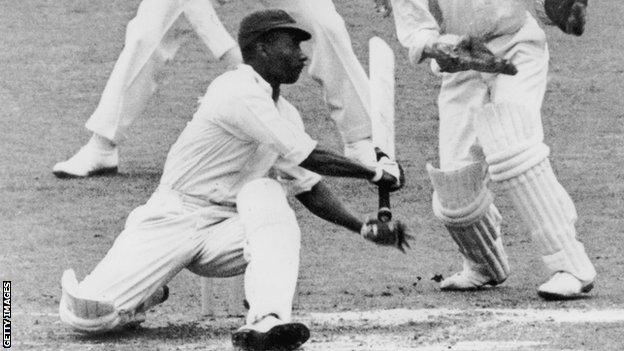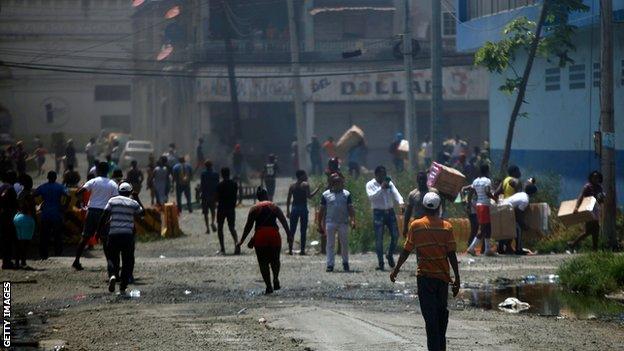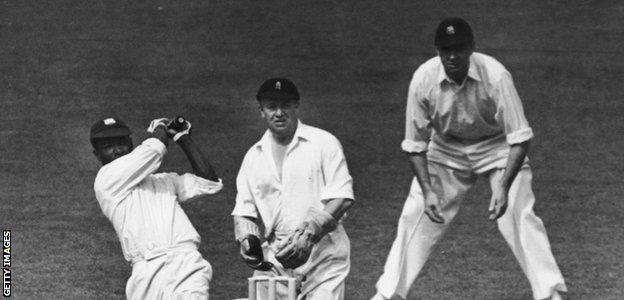George Headley: How great West Indian batter’s brilliance was shaped by Panama Canal
- Published

George Headley scored 10 hundreds in 22 Tests for the West Indies between 1930 and 1954
The wooden house in the town where Australian legend Don Bradman was born has been turned into a museum.
Yet for the great West Indian batter of the same 1930s era - George Headley - there is not so much as a plaque in the city of his birth.
Nine months the junior of Bradman, who famously ended his Test career with a batting average of 99.94, Headley was born in Colon, Panama on 30 May, 1909.
Headley's ascent to the top of the cricketing world and an indelible place in the game's history is a storied one involving the unlikely-linked Panama Canal construction project, baseball and finally West Indian cricket.

Employment in the Panama Canal Zone brought Headley's 20-year-old father De Coursey from Barbados to the Central American country in March 1908.
Shortly after arriving he met Irene Roberts, a Jamaican woman of a similar age.
In the pier district of Cristobal the following year, the cricketer who legendary writer CLR James was moved to call "the first Caribbean folk hero" entered the world.
Life for many black people in Colon has never been easy.
US engineers and politicians enticed black West Indians, whose ancestors had toiled in the cane fields of the Antilles, to construct the 51-mile waterway to connect the Atlantic and Pacific oceans on the premise they could cope with the harsh tropical climate and diseases.
The thinking was that a mild bout of yellow fever in childhood seemingly protected many West Indians for life, whereas infection tended to prove deadly to other workers.
Yet West Indians were equally as susceptible to malaria, and the snakes and tarantulas in the swamps dredged by them were like nothing they had seen on their island homes.
In the year of Headley's birth, US president William Taft effectively ordered that all black workers in the Panama Canal Zone be moved onto the silver roll.
Aside from better pay, gold workers were entitled to sick and home leave, better housing and more subsidised entertainment. Black people had to use separate toilets and shops.
Despite US-governed segregation of sorts at the time, the young Headley mixed with Panamanian children as a kid.
That explained, in part, why he held no real affection for cricket in his formative years. By the age of eight George mainly spoke in Spanish, however, and like his childhood friends was far more interested in baseball.
Bradman was embedded in cricket culture from a young age, hitting a golf ball against a water tank with a stump for hours on end helped him hone his rotary technique. Yet Headley's early years without a cricket bat in hand did not hamper him. In fact, he felt time on the baseball diamond actually helped shape him as a batter.
A self-taught cricketer - and arguably easier on the eye than Bradman - he claimed that his exceptional eye stemmed from having to watch the ball right out of the pitcher's hand; those free-flowing horizontal bat shots that would confound Test bowlers were a legacy of hitting home runs.

The Panama Canal was completed in August 1914. It is estimated around 20,000 West Indians decided to permanently settle in Panama, but Headley's father was not one of them. De Coursey, who had a few brushes with serious injury at work, moved on to Cuba in 1917 to work on another US project, the Guantanamo Bay naval centre, leaving the family behind in Colon.
By this time his mother Irene, who doted on her first-born, had become concerned about her son's education in Panama.
Schooling for the children of the black people was rudimentary and she made the call when George was 10 to send him 'home' to Kingston, Jamaica for a 'British' education.

Colon saw a general strike in 2018 to protest bad conditions of educational establishments, delays in works of urban renovation, unemployment and security
It was a seminal moment for West Indian cricket. Had the Headleys remained in Panama, or headed to Cuba as a family, it's entirely possible George's life might have been different.
Thankfully, he took up cricket at Calabar Elementary School in Kingston, adapting his baseball skills.
Even though he was smaller in stature, Headley's throwing arm stood out as superior to other youngsters, and he thought nothing of keeping wicket bare-handed, having learned to catch the baseball with soft hands in Panama.
Headley's love for cricket grew as he matured into a teenager, but concerns over whether it could become his full-time profession lingered at 19.
He had worked in various part-time jobs, including as a temporary clerk in a magistrates court, alongside cricket. Indeed, Headley had looked set to move to New York - where his parents had settled and taken US citizenship - to study dentistry.
The delay in his immigration forms being posted brought another critical moment, and he hung around to make his first-class debut for Jamaica against Lord Tennyson's XI in early 1928.
When Headley did eventually make it to New York to visit his parents, he was still having second thoughts about his career. He was working for a subsidiary of the United Fruit Company in Jamaica, and listed his profession as 'fruit selector' rather than 'cricketer' when he entered the US.
Headley may have had further reservations on his Test bow against England at Bridgetown, Barbados in February 1930 during an era when selection in West Indies cricket simmered amid complex parochial inter-island interests and domestic board rivalries. He was booed to the crease by home fans angry that a young Jamaican had taken the place of a Barbadian - ignoring, or unaware, of his father De Coursey's Bajan heritage.
Headley soon wowed them, and the English, with his lightness of feet and front-foot cut shots in a near-faultless 176 in the second innings. He was the first West Indian to score a century on his Test debut and only their second centurion overall.
In the third Test at Georgetown, British Guiana (now Guyana) - he was forced to share a bed with Learie Constantine, such was the sub-standard accommodation for black players.
Yet Headley would be proclaimed an 'immortal' - one of six men to hit centuries in each innings of a Test - inspiring West Indies to their landmark maiden Test win to peg the series with England at 1-1.
There was a gap of five weeks until the finale, to enable the teams to make the long boat journey from British Guiana to Jamaica. En route it would call at Colon, the city of his birth in Panama, affording him a spiritual homecoming of sorts.
At Cristobal pier, yards from where he was born, Headley was greeted by representatives of the West Indian Colony of Panama, led by its president Cyril Lawrence, who waxed lyrical about his achievements.
"Although domiciled in a foreign land, we are keenly interested in everything that attends to the material and social advancement of our homelands," he said. "When the news was flashed to us that you had made the magnificent score of 176... the jubilation of every West Indian was indescribable."

Only three players have a better career Test average than George Headley's 60.83 - Don Bradman (99.94), Adam Voges (61.87) and Graeme Pollock (60.97)
When the ship finally reached Kingston, West Indies and England played a timeless Test to decide the series. England amassed an almost unthinkable 849 in two and a half days. Headley's monumental 223 in the fourth innings - ended when he was stumped on the seventh day's play, and 10th in all - was the last meaningful act before the English had to catch the boat home, so the match was drawn.
Headley ended the series with 703 runs at an average of 87.87. The Jamaican prime minister Michael Manley would write that West Indians had found in Headley "black excellence personified in a white world and a white sport".
In October 1930, the West Indian party for Australia and New Zealand assembled in Colon before making the long journey together across the Pacific.
The Australians would meet with success on their faster pitches by bowling at Headley's midriff, until he altered to a more front-on stance, leaving the legendary leg-spinner Clarrie Grimmett to conclude he was the best leg-side player to whom he ever bowled to.
Headley matched Bradman for centuries in the series - two apiece - but not his weight of runs (336 versus 447). Headley was christened the 'black Bradman', but for the West Indian's avowed fans, Bradman was the white Headley.
West Indies lost the series 4-1, but sailed back having won a Test in Australia for the first time. On the return journey they landed at Colon to be greeted by members a delirious thousand-strong procession.
A further 3,000 crammed into the thoroughfares, as the West Indian population of Panama downed tools to set eyes on their hero Headley.
The four Jamaicans in the party agreed to delay the last leg of their journey home to guest in an exhibition match.
Headley, as the best of the quartet - not to mention the only one black and working-class - was the real draw. It was a match played on a scorched wicket. In keeping with attempts to get the game on throughout much of the region, paraffin was poured on the wicket and set alight in an attempt to dry it.
Indeed, Headley's mastery on wet wickets owed something to these sawdust-and-kerosene experiences in Central America, and CLR James noted his superiority to Bradman in this regard. Headley averaged 39.85, with seven fifties in 13 innings on what James claimed were "wet or uncertain" wickets while Bradman managed just 16.66 in similar conditions, with one half-century in 15 innings.
By 1934 Headley was declared by Wisden as "beyond all question the best batsman the West Indies have ever produced" and dubbed 'Atlas' for carrying West Indies at a time when their batting was weak and inconsistent.
He was tactically astute with a sharp cricket brain, too. Surely only the colour of his skin prevented him from being appointed full-time captain of the West Indies at a time when, more broadly, white colonial interests looked to retain influence as movements demanding independence from the British Empire started to gain traction.
Headley did become the first black man to skipper West Indies side in a one-off Test in 1948, but another 12 years would pass before Frank Worrell would be appointed captain of the team for an entire series.
"Of course I am fully aware of what my grandfather did in the game as a whole," former England cricketer Dean Headley, the third generation of the family to play Test cricket after George and his father Ron, acknowledged.
"But his early years? I know he was born in Colon, spoke Spanish and played baseball but not much more. I met him only once when I was aged 11. But the fact there are some older people in Panama today still called George Headley shows his legacy even in a country where he is not really known."
* This is an adapted extract from the multi-award nominated book Evita Burned Down Our Pavilion: A Cricket Odyssey Through Latin America by Timothy Abraham and James Coyne., external